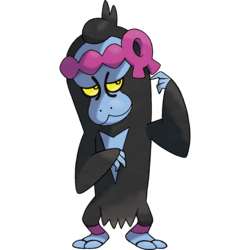From Bulbapedia, the community-driven Pokémon encyclopedia.

|
The subject of this article is a Pokémon which has recently been announced.
This article's contents will change as more information becomes available, perhaps abruptly. Please be cautious when adding information to this article, as rumors and speculation can often be confused with facts. Avoid any information on this subject which is not confirmed by reliable sources.
|
Munkidori (Japanese: マシマシラ Mashimashira) is a Pokémon introduced in Generation IX.
It is not known to evolve into or from any other Pokémon.
Along with Okidogi and Fezandipiti, it is a member of The Loyal Three.
Biology
Munkidori is a blue simian Pokémon with long black fur covering most of its body, except for its face, hands, feet, and part of its chest, the latter forming an arrowhead pattern. Its face has yellow eyes with black striped markings between them, and it has magenta colorations on its rear and ankles. Each of its hands has three fingers, and its feet resemble sandals, each with two toes. Part of its head hair is slicked back, and a magenta chain encircles its head like a headband.
Munkidori, together with Okidogi and Fezandipiti, are known as The Loyal Three, the heroes of Kitakami. They are beloved by the people of Kitakami as heroes that once protected the land from an evil ogre,[1] and stone statues bearing their likenesses were made by the people as an expression of their gratitude.[2]
Trivia
Origin
Munkidori may be based on a monkey, particularly the Japanese macaque.
Munkidori, together with Okidogi, Fezandipiti, and Ogerpon, may reference the Japanese folktale of Momotarō. The tale relates the titular Momotarō, a boy born from inside a peach, who traveled alongside a talking dog, monkey, and pheasant to fight a band of oni (a Japanese folkloric creature commonly equated to ogres in translations).
Name origin
Munkidori may be a combination of monkey and hunky dory (slang meaning that things are good).
Mashimashira may be a combination of 増し mashi (better, improving) and 猿 mashira (archaic word for monkey or ape).
In other languages
| Language
|
Title
|
Meaning
|
 Japanese Japanese
|
マシマシラ Mashimashira
|
From 増し mashi and 猿 mashira
|
 French French
|
Fortusimia
|
From fortune and simia
|
 Spanish Spanish
|
Munkidori
|
Same as English name
|
 German German
|
Benesaru
|
From bene and 猿 saru
|
 Italian Italian
|
Munkidori
|
Same as English name
|
 Korean Korean
|
이야후 Iyahu
|
From 이야호 iyaho and 후 (猴) hu
|
 Mandarin Chinese Mandarin Chinese
|
願增猿 / 愿增猿 Yuànzēngyuán
|
From 願 / 愿 yuàn, 增 zēng, and 猿 yuán
|
 Cantonese Chinese Cantonese Chinese
|
願增猿 Yuhnjāngyùhn
|
From 願 yuhn, 增 jāng, and 猿 yùhn
|
|
|
|
|
|
|
|
Related articles
References
External links

|
This Pokémon article is part of Project Pokédex, a Bulbapedia project that aims to write comprehensive articles on each Pokémon species, as well as Pokémon groups and forms.
|


